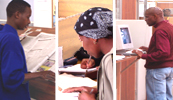
| Internet |
 |




Searching techniques:
Information finding tools:
Information sources:
Web address
Internet address
An Internet address, such as http://www.microsoft.com, is called a URL (uniform resource locator). This address works the same as a telephone number or a street address - in other words it is the address that will take you to the site/information you are looking for.
An Internet address indicates a number of things, such as:
Commercial web sites
 |
 |
 |
| The following are commercial web sites, distinguished by the co or com designator at the end. | ||
 |
 |
 |
| www.xsinet.co.za | ||
 |
 |
 |
| www.xsinet.co.za | ||
 |
 |
 |
Academic or educational web sites
 |
 |
 |
| The following are academic or educational web sites, identified by the ac or edu. | ||
 |
 |
 |
| www.wits.ac.za | ||
 |
 |
 |
| www.harvard.edu | ||
 |
 |
 |
Organisation's web sites
 |
 |
 |
| The following is a web site of an organisation, identified by the org designator. | ||
 |
 |
 |
| www.saep.org | ||
 |
 |
 |
Network web sites
 |
 |
 |
| The following is a web site of a network, identified by the net designator. | ||
 |
 |
 |
| www.itn.net | ||
 |
 |
 |
Different countries
 |
 |
 |
 |
 |
| Country indicators are usually given at the end of the address. See the following examples: | ||||
 |
 |
 |
 |
 |
| www.mweb.co.za | The za designator is for South Africa. | |||
 |
 |
 |
 |
 |
 |
www.nla.gov.au | The au designator is for Australia, and so on. |  |
|
 |
 |
 |
 |
 |
| Note that United States of America web sites do not have a country indicator at the end of the address. | ||||
 |
 |
 |
 |
 |
